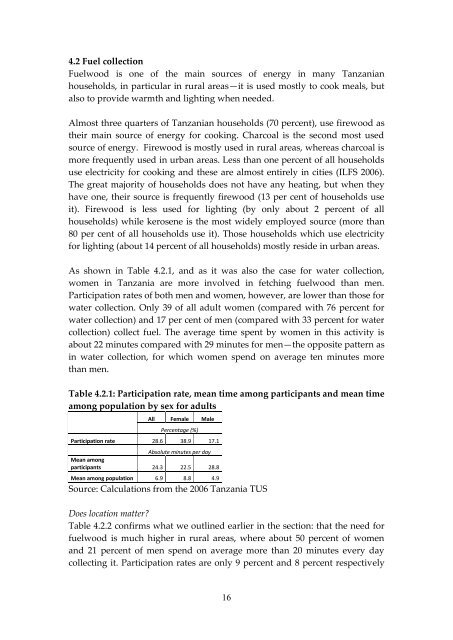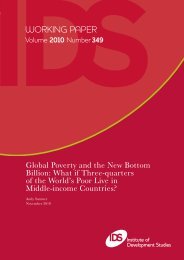Patterns of time use in Tanzania: how to make public investment in ...
Patterns of time use in Tanzania: how to make public investment in ...
Patterns of time use in Tanzania: how to make public investment in ...
You also want an ePaper? Increase the reach of your titles
YUMPU automatically turns print PDFs into web optimized ePapers that Google loves.
4.2 Fuel collection<br />
Fuelwood is one <strong>of</strong> the ma<strong>in</strong> sources <strong>of</strong> energy <strong>in</strong> many <strong>Tanzania</strong>n<br />
ho<strong>use</strong>holds, <strong>in</strong> particular <strong>in</strong> rural areas—it is <strong>use</strong>d mostly <strong>to</strong> cook meals, but<br />
also <strong>to</strong> provide warmth and light<strong>in</strong>g when needed.<br />
Almost three quarters <strong>of</strong> <strong>Tanzania</strong>n ho<strong>use</strong>holds (70 percent), <strong>use</strong> firewood as<br />
their ma<strong>in</strong> source <strong>of</strong> energy for cook<strong>in</strong>g. Charcoal is the second most <strong>use</strong>d<br />
source <strong>of</strong> energy. Firewood is mostly <strong>use</strong>d <strong>in</strong> rural areas, whereas charcoal is<br />
more frequently <strong>use</strong>d <strong>in</strong> urban areas. Less than one percent <strong>of</strong> all ho<strong>use</strong>holds<br />
<strong>use</strong> electricity for cook<strong>in</strong>g and these are almost entirely <strong>in</strong> cities (ILFS 2006).<br />
The great majority <strong>of</strong> ho<strong>use</strong>holds does not have any heat<strong>in</strong>g, but when they<br />
have one, their source is frequently firewood (13 per cent <strong>of</strong> ho<strong>use</strong>holds <strong>use</strong><br />
it). Firewood is less <strong>use</strong>d for light<strong>in</strong>g (by only about 2 percent <strong>of</strong> all<br />
ho<strong>use</strong>holds) while kerosene is the most widely employed source (more than<br />
80 per cent <strong>of</strong> all ho<strong>use</strong>holds <strong>use</strong> it). Those ho<strong>use</strong>holds which <strong>use</strong> electricity<br />
for light<strong>in</strong>g (about 14 percent <strong>of</strong> all ho<strong>use</strong>holds) mostly reside <strong>in</strong> urban areas.<br />
As s<strong>how</strong>n <strong>in</strong> Table 4.2.1, and as it was also the case for water collection,<br />
women <strong>in</strong> <strong>Tanzania</strong> are more <strong>in</strong>volved <strong>in</strong> fetch<strong>in</strong>g fuelwood than men.<br />
Participation rates <strong>of</strong> both men and women, <strong>how</strong>ever, are lower than those for<br />
water collection. Only 39 <strong>of</strong> all adult women (compared with 76 percent for<br />
water collection) and 17 per cent <strong>of</strong> men (compared with 33 percent for water<br />
collection) collect fuel. The average <strong>time</strong> spent by women <strong>in</strong> this activity is<br />
about 22 m<strong>in</strong>utes compared with 29 m<strong>in</strong>utes for men—the opposite pattern as<br />
<strong>in</strong> water collection, for which women spend on average ten m<strong>in</strong>utes more<br />
than men.<br />
Table 4.2.1: Participation rate, mean <strong>time</strong> among participants and mean <strong>time</strong><br />
among population by sex for adults<br />
All Female Male<br />
Percentage (%)<br />
Participation rate 28.6 38.9 17.1<br />
Absolute m<strong>in</strong>utes per day<br />
Mean among<br />
participants 24.3 22.5 28.8<br />
Mean among population 6.9 8.8 4.9<br />
Source: Calculations from the 2006 <strong>Tanzania</strong> TUS<br />
Does location matter?<br />
Table 4.2.2 confirms what we outl<strong>in</strong>ed earlier <strong>in</strong> the section: that the need for<br />
fuelwood is much higher <strong>in</strong> rural areas, where about 50 percent <strong>of</strong> women<br />
and 21 percent <strong>of</strong> men spend on average more than 20 m<strong>in</strong>utes every day<br />
collect<strong>in</strong>g it. Participation rates are only 9 percent and 8 percent respectively<br />
16

















